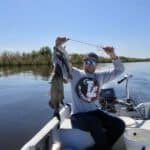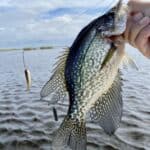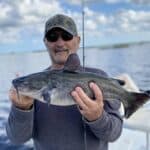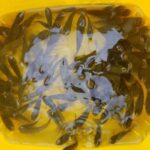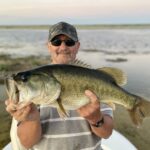Old timers talk about ‘fishing the secret crappie hole‘…and ‘bait that crappie hole for the weekend‘…but is there any truth to this method?
What is a crappie hole? And how do you find them and bait them?
In this article i’m going to answer all those questions and more!
Table of Contents
What Is A Crappie Hole?
Finding and baiting a crappie hole is easy if you know what you’re looking for. You need to look for a sheltered area near shore with plenty of cover and food. Then you can improve it by baiting it and making it an even better food source for the crappie.
A crappie hole is a name for any spot where crappie congregate to feed all year round and are therefore great spots to fish all year. Despite the name, crappie holes need not be deep. In fact, they tend to be in shallower water or surrounded by shallow water.
Spawning beds and deep structure aren’t crappie holes, because they’re only used part of the time. A crappie hole is a place where crappie fishing is good any time of year that there isn’t ice on the water, and where fish naturally congregate.
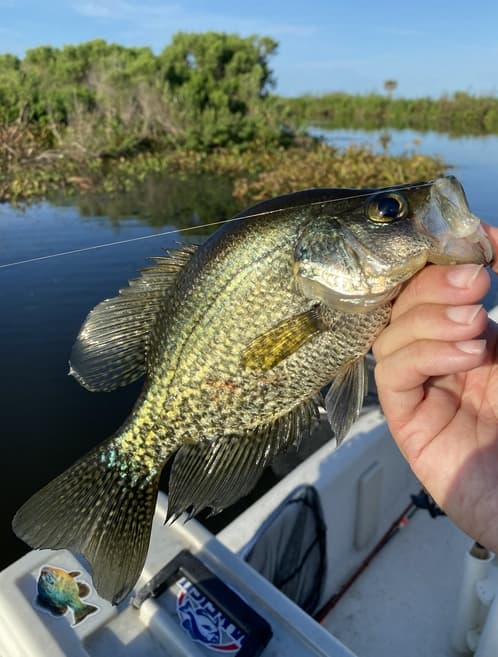
So, what are the characteristics of a crappie hole? They tend to be near shore, sheltered from current, sheltered from predators, and with a good supply of food.
Crappie holes will have some kind of vegetation to provide food and cover for the things crappie eat, and some structure or debris for cover and to break the current.
Crappie holes tend to be near the shore because this is where the protection from the current is, and where smaller baitfish and forage live.
The value of calm water is twofold: it allows the crappie to conserve energy while hunting and it allows the crappie’s food-all of which is smaller and more uncomfortable in fast water-to live there comfortably.
Since crappie live and travel in schools, once you find a good crappie hole you can expect to catch a whole bunch of them!
How To Locate A Secret Crappie Hole
Basically, any place that has proper food and shelter has the potential to be a good crappie hole. If you are looking at a body of water and hunting for a crappie hole, there are a couple of common guideposts that will point you to an area where schools of crappie may cluster.
Bottlenecks
School of crappie like to travel from food source to food source or from deep to shallow and back. Sometimes, an area where their path narrows can concentrate them.
Generally, in a river or stream, this isn’t good because the narrower bed means increased current.
A culvert under a causeway is a perfect example of a good bottleneck. If a causeway crosses a lake, fish have to use the culverts to get back and forth, and since the water is calm, they may hang around there to hunt in the shallows.
Eddies
Eddies are calm areas in a current created by some obstruction like a big rock or fallen tree. This creates a placid, shallow pocket that’s perfect for crappie. Backwater eddies near dam spillways are particularly good.
Make Your Own!
Maybe more than any other freshwater fish, people go out of their way to create habitat for crappie.
Some lakes even have publicly created stake beds to make crappie fishing better. Others sink Christmas trees or PVC fish attractors to create crappie holes.
If you can find any of these man-made holes, or make them yourselves, you’re set!
How To Bait A Crappie Hole
Once you’ve found your crappie hole, you’re good to go, but you can make it even better by baiting it.
By baiting, you can draw more crappie in more consistently for even better fishing than you would have naturally.
You May Also Like: The Best Crappie Baits & Lures To Catch Slabs All Year Long!
There are two basic ways to bait a crappie hole. The first is hand baiting and the second is bait attraction.
Hand Baiting
Hand baiting is just what it sounds likes. You paddle or walk to your crappie hole and throw some bait in. This might be handfuls of worms, or it might be minnows that you caught elsewhere and toss into your hole.
Obviously, this is pretty labor-intensive. You need to throw in new bait fairly frequently as the old stuff gets eaten, drifts, or swims away.
One old timer trick is to take a bunch of minnows and keep them in some kind of container that allows water to pass through easily (like a glass jar with holes in the lid).
You set the container in the water and the crappie can see and smell the minnows, but can’t get to them! They also can’t swim away.
Does it really work? Well, some people swear by this old school method…
Some fishermen also dye the bait the color of the lures they intend to use before throwing it in such as neon green or neon orange.
Bait Attraction
Bait attraction works by throwing things into the hole not because they’re attractive to crappie, but because they’re attractive to the crappie’s food.
This has the advantage of being much less labor-intensive than hand baiting, and probably more effective. The food species are drawn into the hole and hopefully stay there, making it extremely attractive to any passing crappie.
The method is pretty simple. Get some kind of permeable container like a burlap feed sack or onion sack. Put a rock in it as a sinker, fill it with bait like cornmeal, hog feed, or fish scraps and sink it in the hole.
Another type of container is a 5-gallon bucket with a lid. You put an inch of cement in the bottom, then drill holes all around the bucket to allow free water flow. Put in your bait, put on the lid, and you have your bait container.
The container should be attached to a rope which you can tie off to a log or something else for easy retrieval and reloading.
The two most common baits are dry dog food and range cubes. Range cubes are a type of high-protein livestock feed.
If you want to keep your secret crappie hole truly secret, make sure to disguise the bait container rope really well. Otherwise, fisherman drifting by and recognizing it for what it is will be casting for your fish and the hole won’t be secret anymore!
NOTE: Always check with local fish and game laws in you area. It may not be legal to bait, or sink artificial containers or attractors in you area.
How To Fish A Crappie Hole
The first thing to remember is that while crappie may stay there all day in the spring and in the fall, once it starts to get hotter the crappie will move into deeper water, or under cover for a good part of the day.
Crappie are very light sensitive, so you want to focus your time in your hole in the early morning and right before dark when it’s cooler.
Since this is the most active time for crappie feeding anyway, it’s not a bad tactic for the rest of the year either.
If you’ve been direct baiting, put the bait you’ve been throwing in on your hook, or at least match your lure to look like it. This includes color, especially if you’ve been dyeing your bait.
Always try and anchor your boat, or fish from the bank upstream and mind the sun. You want to keep your shadow and/or boat away from the area so you don’t spook fish.
For a crappie hole that’s an eddy off the main current, cast into that current so that it carries your bait into the eddy. Crappie love lurking in the calm water right on the edge of the current, waiting to grab whatever washes in!
Final Thoughts
Crappie holes may become a thing of the past, as the next generation of anglers focuses more on technology to be successful…
But maybe those old-timers were onto something?
I’ll let you be the judge. Good luck!
See Also: 3 Easy Differences Between Black Crappie vs White Crappie
If you haven’t guessed yet, I love fishing and everything about it!
To learn more about why I started Panfish Nation, visit the About page and follow along on Social Media:


Download a copy of my FREE Lure Color Selection Chart & Knot Guide!
Stay up to date with fishing reports, tackle reviews, industry news, and much more! We respect your privacy, unsubscribe at any time.

